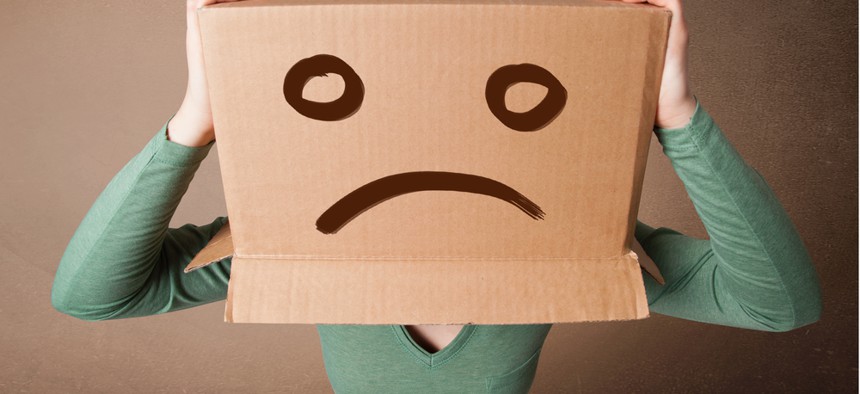
ra2studio/Shutterstock.com
The Origins of the Anger Face
Why humans have evolved to flare their nostrils, furrow their brows, and frown
In the U.S., the thumbs-up is typically a gesture that everything’s just hunky-dory—but in the Middle East, it implies that the gesturer is about to do something decidedly unfriendly with that thumb and another person’s anatomy. In Brazil, the “OK” sign—another innocuous move in America—is an obscene way of saying that things are definitely not OK. And in Greece, facing your palm towards another person doesn’t imply a sassy 90s-throwback “talk to the hand” reference so much as a desire to rub excrement in another person’s face.
But while these particular pieces of body language differ wildly in meaning depending on where they take place, the response to an offensive gesture anywhere in the world will likely look the same: nostrils flared, lips thinned, chin pushed up and out. In other words, the natural human anger face.
Unvarying across cultures, the expression of anger is made even by children who have been blind since birth, a fact used by evolutionary psychologists to argue that it’s innate rather than learned. While conventional scientific wisdom has previously held that the anger face is an arbitrary set of features that we’ve simply come to understand as an indicator of anger, new research suggests that it may actually serve a more specific purpose: On its own, each aspect of the anger face may make its wearer appear physically stronger.
“If you think of anger as a signal, then any old signal will do,” says Aaron Sell, a psychology professor at Griffith University in Australia. “You could raise one eyebrow, you could stick your tongue out—it could be anything. But what natural selection appears to have done is tailored a pretty complicated display.”
In a study recently published in the journalEvolution and Human Behavior, Sell and colleagues from the University of California, Santa Barbara tested the effects of each individual feature of the anger face on a person’s overall appearance, using seven previously identified components of anger: Along with changes to the nostrils, lips, and chin, the brow and brow ridge both lower and the cheekbones and mouth both raise.
Starting from a computer-simulated image of a 20-year-old man, the researchers created pairs of faces for each of the seven features—one face neutral, one face with the anger-related change—and asked volunteers to assess each one for physical strength. Across the board, the faces with a single feature activated—neutral except for flared nostrils, for example—were rated as belonging to stronger men.
One reason for this link, Sell says, may be because of the increased leverage that fighting ability afforded our ancestors in resolving conflicts of interest: The more physically threatening a person looked, the more bargaining power they had to influence the outcome of a given situation. “The reason natural selection designed [the anger face] is that the individuals who made that face out-reproduced the other ones,” he explains. “And they out-reproduced them because the people who made that face won their conflicts. The other people backed down because they looked at them and thought, ‘Wow, he looks really tough.’”
The concept of aggression as an assertion of the upper hand has been well-documented in scientific literature, and anger faces are thought to be more easily identified than other expressions of emotion, allowing for more efficient responses to perceived threats. Previous research from Sell has also found that both genders can more readily identify expressions of anger on men—who are more likely to be aggressors, evolutionarily speaking—than on women, and thatmen with greater upper-body strength and more attractive women—two groups that, in the early days of humanity, would have had increased bargaining power—may also be quicker to anger than their weaker or less attractive peers.
But a separate study, published in 2005 in Personality and Social Psychology Bulletin, argues that the anger face evolved to enhance the wearer’s threatening nature by creating an older appearance, rather than a stronger one: “The origins of the appearance of anger and fear facial expressions … might lie in the expression’s resemblance to, respectively, mature and babyish faces.”
“The data shows that each of the components make you look stronger pretty much regardless of if you’re old or young,” Sell explains.
By contrast, “fighting ability peaks sometime in the late 20s, early 30s,” he says. “So if you make someone young look older, they will possibly also look stronger, since those two variables are correlated. But they become uncorrelated later in life—if you’re dealing with 60-year-old men, then looking older than 60 is going to make you look weaker.”
But, he adds, there are other types of anger that don’t necessarily trigger the urge to become aggressive. A particularly offensive move from a stranger may cause a person to go into confrontation mode, but the same act from a loved one may prompt the opposite response—a flat voice and a blank stare.
“You have two ways of bargaining with someone. One is hurting [them] and the other is saying, ‘I’m not cooperating with you anymore,’” he explains. “You come home and you say to your spouse, ‘Hi, how are you doing?’ and they look at you with a plain face. Now you know they’re angry, because they look at you like you’re a stranger … it’s the withdrawal of affect.”
Choose your anger style selectively, in other words. The middle finger may get the point across, but depending who’s on the receiving end, the silent treatment may be more persuasive. Just tell them to talk to the hand.
(Image via ra2studio/Shutterstock.com)






